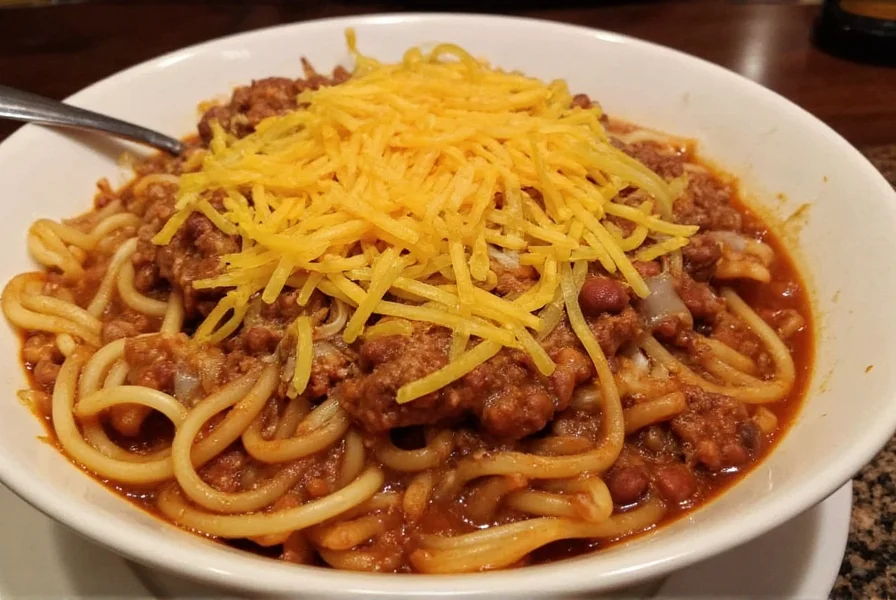Cincinnati chili confuses many first-time visitors expecting a traditional bowl of spicy meat. This unique regional specialty represents one of America’s most distinctive culinary traditions, with deep roots in early 20th century immigrant culture. Understanding what makes Cincinnati-style chili different requires examining its unexpected ingredients, serving methods, and cultural significance.
The True Nature of Cincinnati Chili
Despite its name, Cincinnati chili bears little resemblance to Texas-style or chili con carne. The dish consists of a finely minced meat sauce simmered with Mediterranean spices, served as a topping for spaghetti. The ‘chili’ designation comes from early Greek and Macedonian immigrants who adapted their native meat sauces to American tastes, calling it ‘chili’ as a familiar term for spiced meat.
Authentic Cincinnati chili features a distinctive flavor profile with subtle sweetness from spices like cinnamon and allspice, creating a complex taste that surprises those expecting fiery heat. The sauce maintains a relatively thin consistency compared to chunky chili varieties, allowing it to coat spaghetti properly.

Historical Origins and Cultural Evolution
Cincinnati chili emerged in the 1920s through Greek and Macedonian immigrants who opened restaurants serving adapted versions of their traditional meat sauces. Tom Kiradjieff, a Macedonian immigrant, created the first version at his restaurant Empress in 1922, developing the now-famous ‘ways’ serving system.
The dish gained popularity through competing chains like Skyline Chili and Gold Star Chili, which expanded throughout the Cincinnati metropolitan area. These establishments standardized the preparation methods and serving styles that define authentic Cincinnati chili today. The regional specialty has become so ingrained in local culture that Cincinnati hosts an annual chili festival celebrating this unique culinary tradition.
Signature Ingredients and Flavor Profile
The distinctive taste of Cincinnati chili comes from its unique spice blend, which typically includes:
- Finely ground beef (sometimes with少量 pork)
- Cinnamon
- Allspice
- Cloves
- Worcestershire sauce
- Vinegar
- Tomato paste
Unlike traditional chili recipes, Cincinnati-style contains no chili powder as the primary spice. The warm baking spices create a complex flavor profile that’s subtly sweet rather than aggressively spicy. Most authentic recipes maintain a mild heat level, focusing instead on the aromatic spice blend.
| Feature | Cincinnati Chili | Traditional Chili |
|---|---|---|
| Base | Thin meat sauce | Thick stew |
| Primary Spices | Cinnamon, allspice, cloves | Chili powder, cumin |
| Serving Style | Over spaghetti with toppings | Standalone bowl |
| Heat Level | Mild | Medium to hot |
| Beans | Optional topping | Often included |
The ‘Ways’ System Explained
Cincinnati chili restaurants serve their specialty using a numbered ‘ways’ system that specifies topping combinations:
- 2-way: Chili served over spaghetti
- 3-way: Chili and spaghetti with either cheese, onions, or beans
- 4-way: Chili, spaghetti, and two toppings (cheese + onions, cheese + beans, or onions + beans)
- 5-way: Chili, spaghetti, cheese, onions, and beans
This standardized ordering system developed as chains like Skyline and Gold Star expanded, creating consistency across locations. The most popular combination remains the 3-way with cheese, though regional preferences vary throughout Greater Cincinnati.
Preparing Authentic Cincinnati Chili at Home
Creating genuine Cincinnati-style chili requires attention to specific techniques. The meat should be finely minced or ground to achieve the proper texture. Authentic recipes call for simmering the sauce for several hours to develop flavors without reducing it too much, maintaining that characteristic thin consistency.
When making Cincinnati chili recipe authentic style, avoid common mistakes like using chili powder as the primary spice or making the sauce too thick. The distinctive flavor comes from the balance of warm spices rather than heat. Many home cooks find success by toasting whole spices before grinding them for maximum flavor extraction.

Cultural Significance in Cincinnati
Cincinnati chili represents more than just food—it’s a cultural institution. The city contains more chili parlors per capita than any other American city, with Skyline Chili alone operating over 130 locations. Local sports fans often celebrate Reds or Bengals victories with a trip to their favorite chili spot.
The dish has become so emblematic of Cincinnati identity that newcomers often experience it as a rite of passage. Despite frequent confusion from outsiders, Cincinnatians fiercely defend their unique culinary tradition, which continues evolving while maintaining its distinctive character.
Frequently Asked Questions
Why is Cincinnati chili served over spaghetti?
Cincinnati chili is served over spaghetti because early Greek and Macedonian immigrants adapted their traditional meat sauces to American tastes by serving them on spaghetti, which was already familiar to Americans. This presentation differentiated it from traditional chili con carne and created the unique regional specialty we know today.
Does Cincinnati chili contain chocolate or coffee?
Authentic Cincinnati chili recipes do not typically contain chocolate or coffee. The distinctive flavor comes from warm spices like cinnamon, allspice, and cloves. Some modern variations might include these ingredients, but they're not part of the traditional preparation method used by Cincinnati's established chili parlors.
How spicy is genuine Cincinnati chili?
Traditional Cincinnati chili is notably mild in heat. The flavor profile emphasizes aromatic spices like cinnamon and allspice rather than chili heat. Most authentic recipes produce a sauce with subtle warmth but not significant spiciness, making it accessible to a wide range of palates. Customers can add hot sauce if they prefer more heat.
What makes Cincinnati chili different from Michigan hot dogs?
While both are regional specialties featuring meat sauces, Cincinnati chili and Michigan hot dogs differ significantly. Cincinnati chili uses Mediterranean spices and is served over spaghetti in specific ‘ways,’ while Michigan hot dogs feature a meaty tomato-based sauce with no distinctive warm spices, served exclusively on hot dogs. The flavor profiles, serving methods, and cultural contexts differ substantially between these two regional specialties.











 浙公网安备
33010002000092号
浙公网安备
33010002000092号 浙B2-20120091-4
浙B2-20120091-4